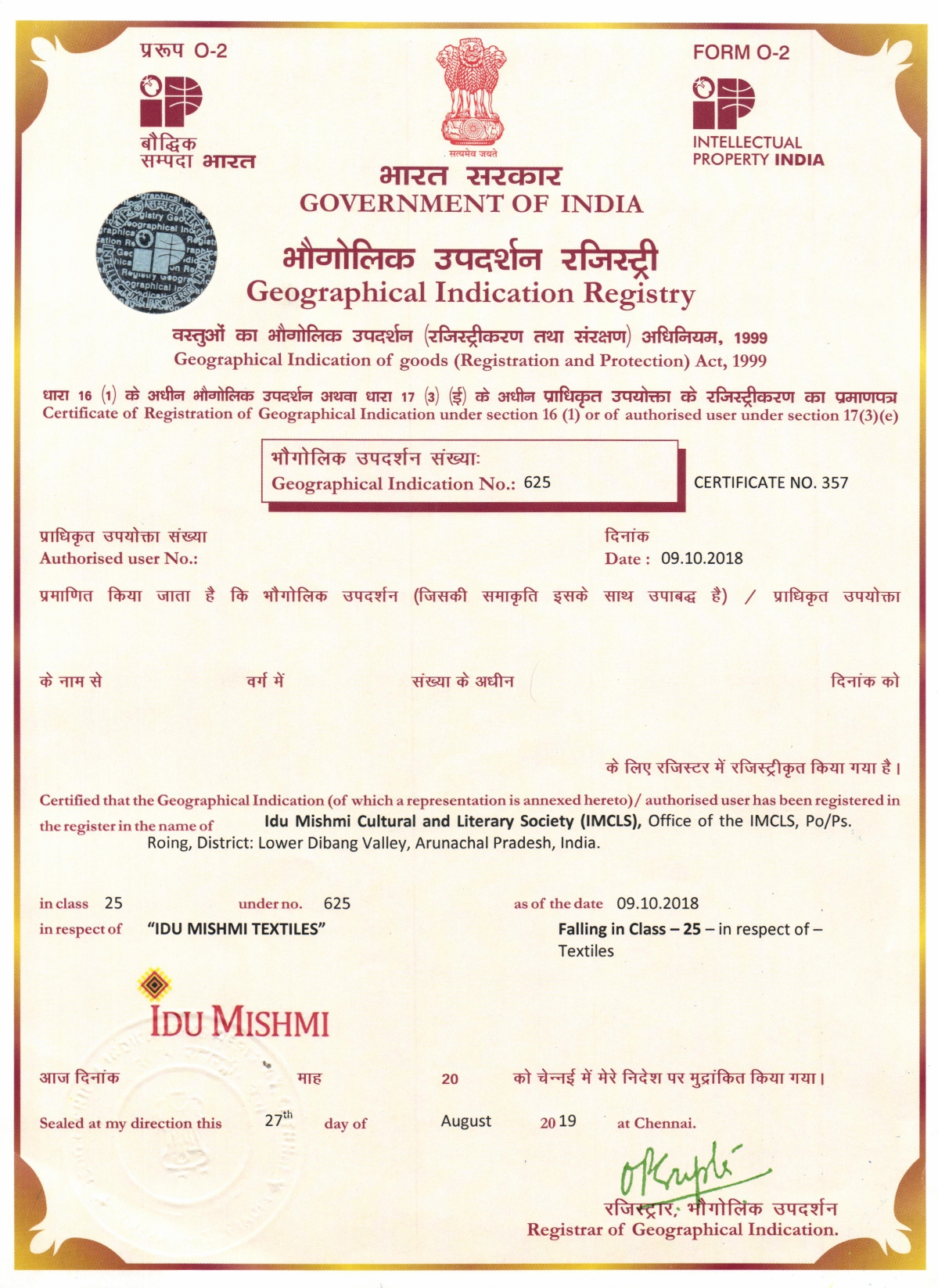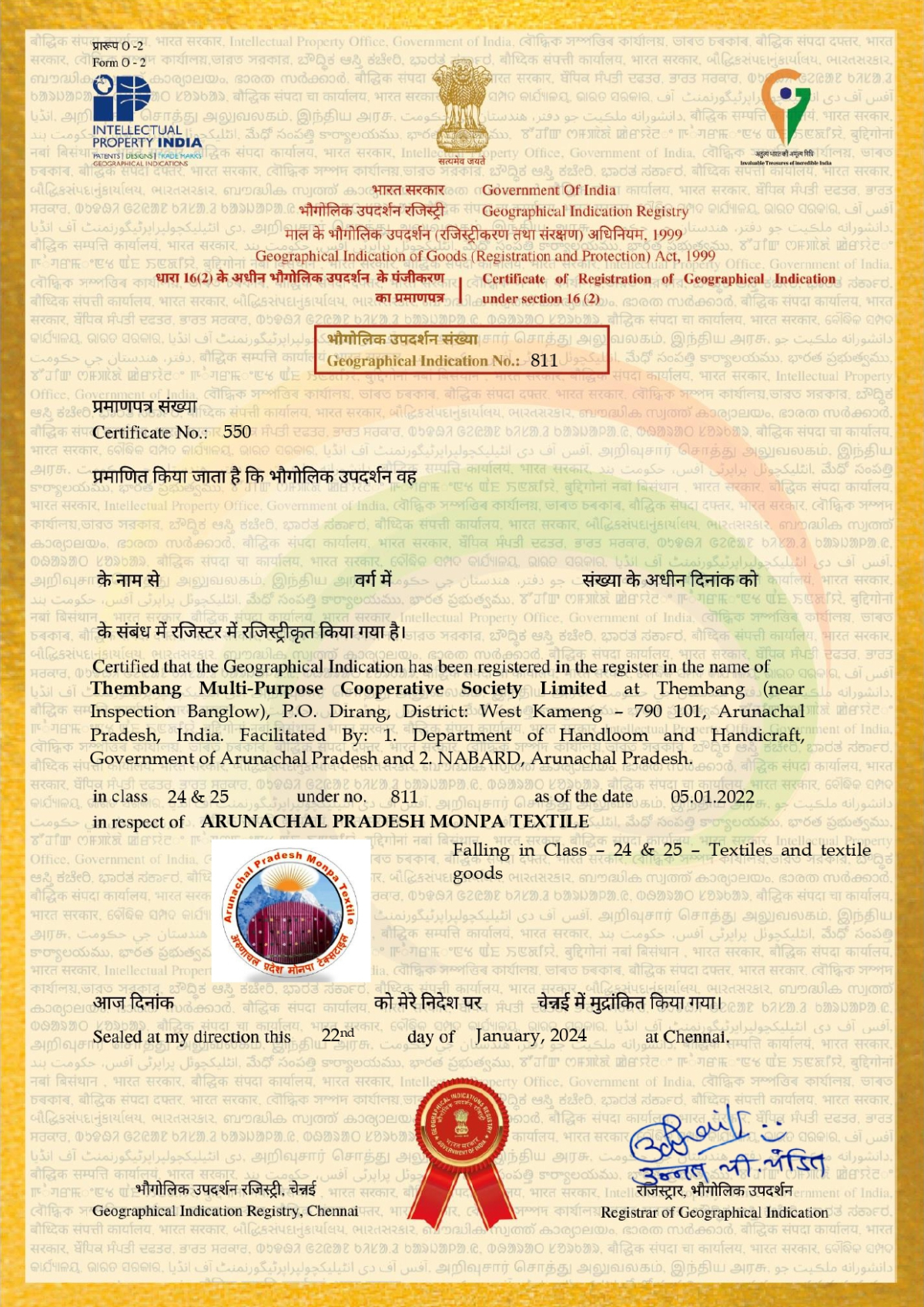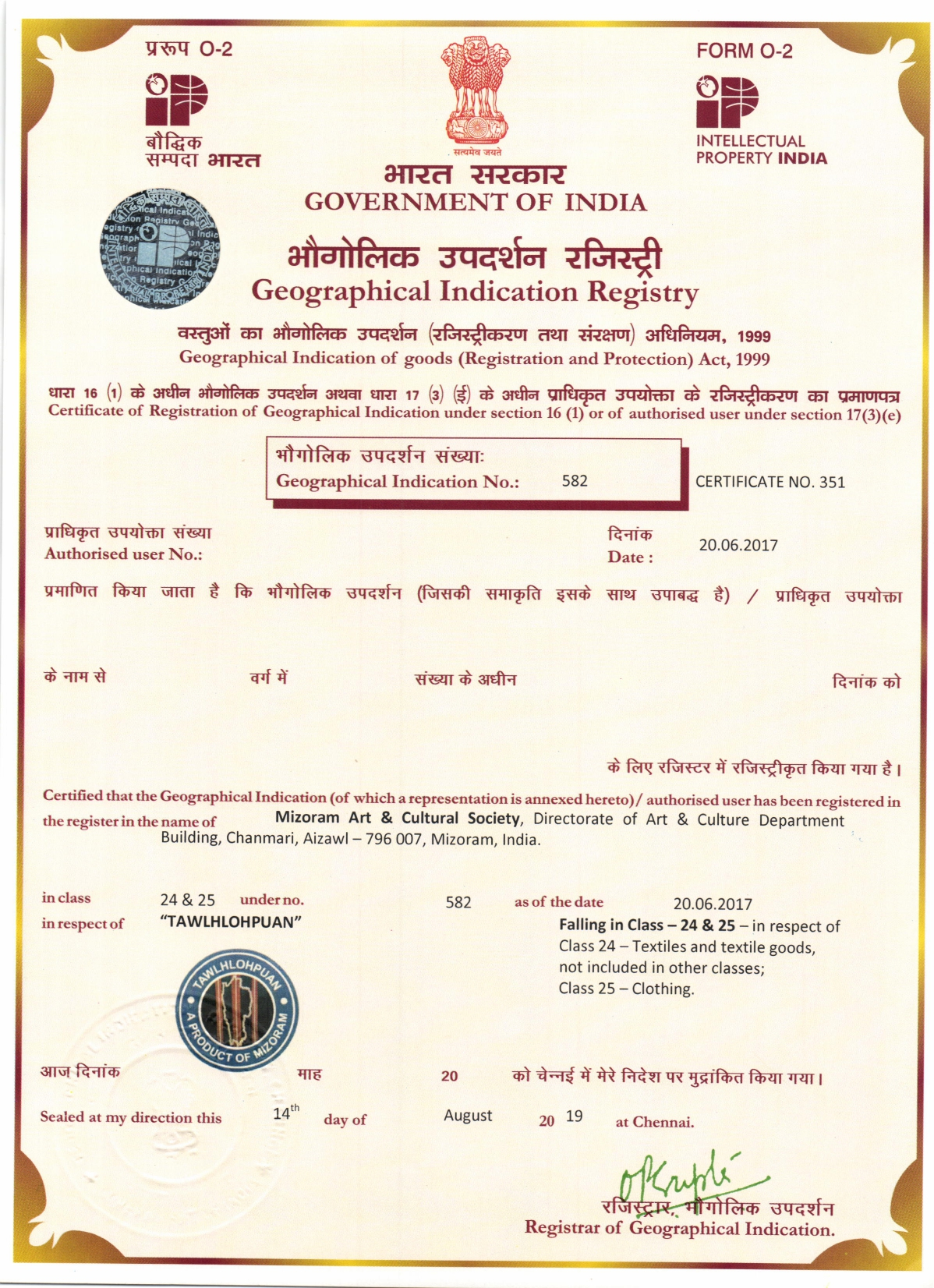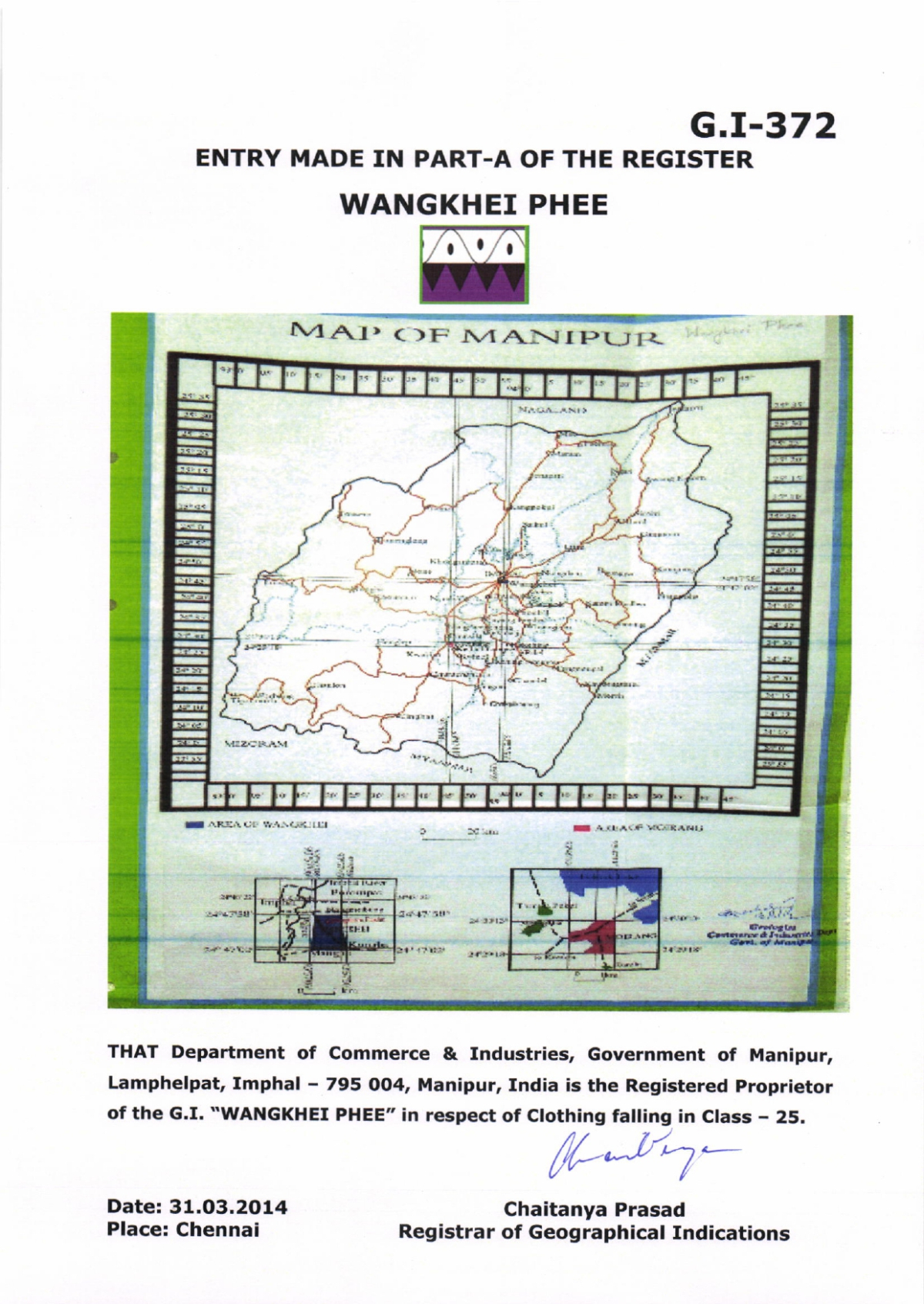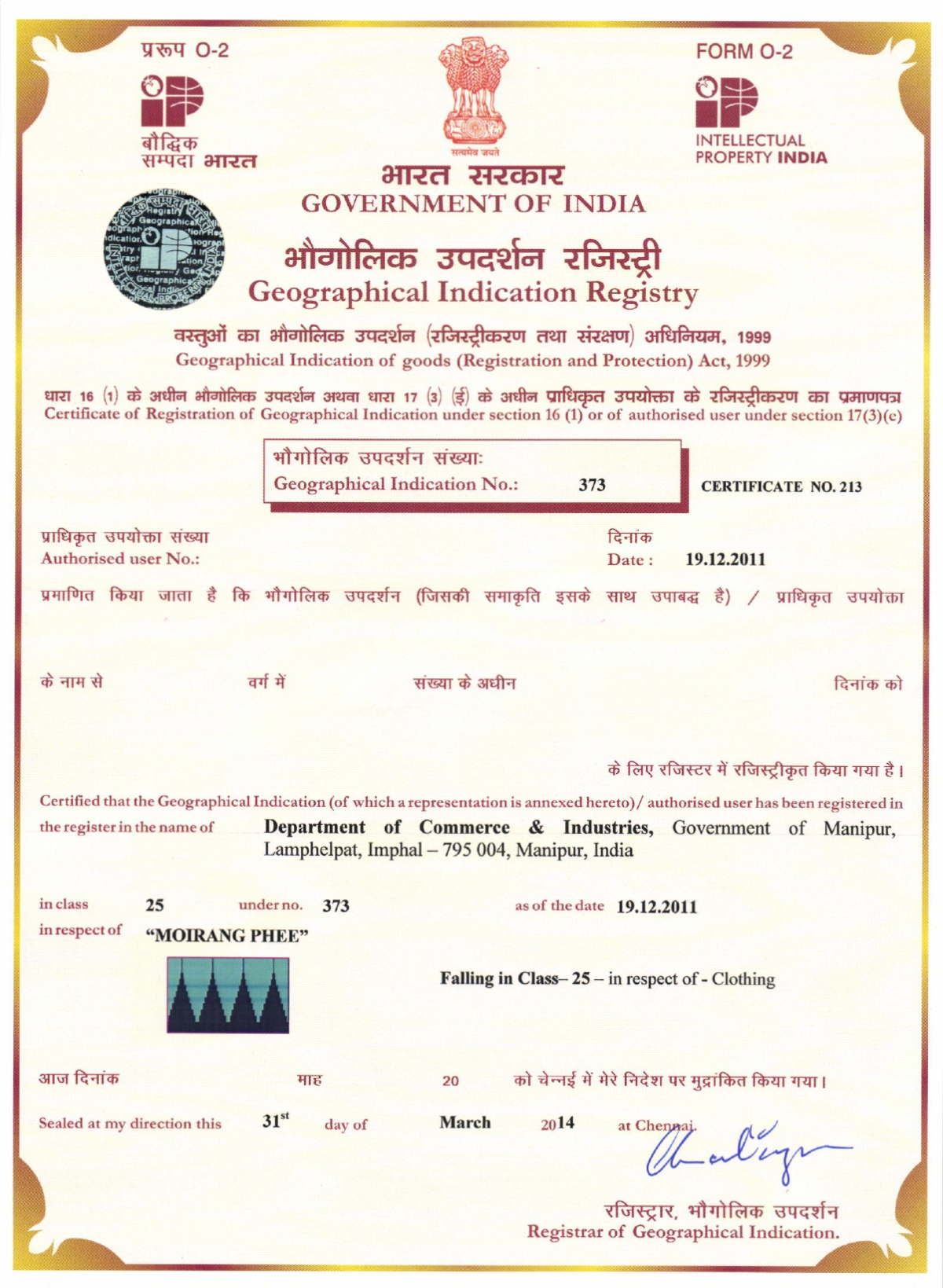
34 GI Products
of North East IndiaApatani Textile
State: Arunachal Pradesh
Apatani Textile is a traditional handwoven fabric produced by the Apatani tribe, who reside in the Ziro Valley of Arunachal Pradesh. These textiles are celebrated for their intricate geometric patterns and vibrant use of natural dyes. Apatani textiles are primarily used for garments such as shawls and headgear, symbolizing the tribe's rich cultural heritage. The art of weaving is deeply rooted in their traditions and passed down through generations, preserving their craftsmanship and unique techniques.

Scan to know more about
Apatani Textile
Assam Asharikandi Terracotta Craft
State: Assam
The Assam Asharikandi Terracotta Craft is one of the most prominent and cherished forms of terracotta artistry in India, originating from Asharikandi village in Assam. This craft has been practiced for generations and is known for its distinctive blend of tradition and creative expression. The artisans of Asharikandi create a variety of terracotta items, ranging from traditional idols to everyday utility objects, with each piece reflecting the rich cultural heritage of Assam. This craft is not only a means of livelihood for many families in the region but also a vital representation of the artistic soul of Assam.

Scan to know more about
Assam Asharikandi Terracotta Craft
Assam Pani Mateka Craft
State: Assam
The Assam Pani Mateka Craft is a traditional earthenware craft that has been an integral part of Assamese rural life for centuries. This craft involves the creation of water pots, or "mateka," using natural clay. These earthen pots are known for their ability to keep water cool naturally, making them an essential household item in the hot and humid climate of Assam. The artisans who create these pots have preserved their craft through generations, using traditional methods and materials that remain environmentally sustainable.

Scan to know more about
Assam Pani Mateka Craft
Idu Mishmi Textile
State: Arunachal Pradesh
Idu Mishmi Textile is a handwoven fabric created by the Idu Mishmi tribe, an indigenous community residing in the Dibang Valley of Arunachal Pradesh. These textiles are known for their intricate designs, bright colors, and symbolic patterns, often representing elements from nature and the tribe's mythology. Traditionally used for clothing like shawls and waist belts, Idu Mishmi textiles hold deep cultural and spiritual significance and are integral to the tribe's identity.

Scan to know more about
Idu Mishmi Textile
Monpa Textile
State: Arunachal Pradesh
Monpa Textile is a traditional fabric handwoven by the Monpa tribe, who are primarily found in the Tawang and West Kameng districts of Arunachal Pradesh. These textiles are known for their vibrant colors and intricate designs, which often reflect the tribe's Tibetan Buddhist heritage. Monpa textiles are used to create various garments, including shawls and ceremonial items, and are deeply intertwined with the community's cultural and spiritual practices.

Scan to know more about
Monpa Textile
Nyshi Textile
State: Arunachal Pradesh
Nyshi Textile is a traditional handwoven fabric produced by the Nyshi tribe of Arunachal Pradesh. Known for its bold colors and geometric designs, this textile is used in creating garments and accessories that are an integral part of the tribe’s cultural identity. The textile is made using handlooms and natural fibers, reflecting the Nyshi tribe’s sustainable practices.

Scan to know more about
Nyshi Textile
Tangsa Textile
State: Arunachal Pradesh
Tangsa Textile is a traditional handwoven fabric crafted by the Tangsa tribe, which is predominantly found in the Changlang district of Arunachal Pradesh. These textiles are known for their vibrant colors and intricate designs, which reflect the tribe’s close relationship with nature. The textiles are primarily used to create traditional garments and ceremonial items, making them an essential part of the Tangsa tribe’s cultural identity.

Scan to know more about
Tangsa Textile
Tai Khamti Textile
State: Arunachal Pradesh
Tai Khamti Textile is a traditional handwoven fabric produced by the Tai Khamti community, who reside in the Namsai district of Arunachal Pradesh. Known for its intricate designs and vibrant colors, Tai Khamti textiles are deeply influenced by the community’s Buddhist faith. The textiles are used to create traditional garments and ceremonial items, playing an important role in the cultural and spiritual life of the Tai Khamti people.

Scan to know more about
Tai Khamti Textile
Handmade Carpet
State: Arunachal Pradesh
Handmade Carpets from Arunachal Pradesh are crafted by the local indigenous communities, primarily in the districts of Tawang and West Kameng. Known for their intricate patterns, vibrant colors, and excellent craftsmanship, these carpets are hand-knotted using wool sourced from local sheep. The designs of these carpets are deeply influenced by Tibetan art and Buddhist symbols, reflecting the region’s cultural heritage. They are highly valued for both their aesthetic appeal and the skill required to produce them.

Scan to know more about
Handmade Carpet
Galo Textile
State: Arunachal Pradesh
Galo Textile is a handwoven fabric crafted by the Galo tribe, who predominantly reside in the West Siang district of Arunachal Pradesh. Known for their vibrant colors and intricate geometric patterns, these textiles are deeply embedded in the cultural and social identity of the Galo tribe. They are used in the creation of traditional garments worn during festivals, ceremonies, and other significant events, making them a vital aspect of the tribe’s heritage.

Scan to know more about
Galo Textile
Adi Textile
State: Arunachal Pradesh
Adi Textile is a traditional handwoven fabric crafted by the Adi tribe, who reside in the Siang region of Arunachal Pradesh. These textiles are known for their vibrant colors, intricate patterns, and the use of natural dyes. Adi textiles are used to create traditional garments worn during festivals and ceremonies, symbolizing the tribe’s rich cultural heritage. The craft of weaving has been passed down through generations, ensuring the survival of this ancient art form.

Scan to know more about
Adi Textile
Chakesang Shawl
State: Nagaland
The Chakesang Shawl is a traditional handwoven fabric created by the Chakesang tribe of Nagaland. Known for its bold patterns and vibrant colors, this shawl holds significant cultural importance, being worn during festivals and important social ceremonies. The shawl is symbolic of prestige and is often gifted during weddings and other important life events, signifying its deep-rooted importance in Chakesang society.

Scan to know more about
Chakesang Shawl
Puan Chei
State: Mizoram
Puan Chei is a traditional handwoven fabric from Mizoram, worn by women during festivals and significant cultural ceremonies. This textile is known for its vibrant stripes and intricate patterns, which are a reflection of Mizo cultural identity. Puan Chei is an essential part of traditional Mizo attire and is worn during special occasions such as weddings and dances, symbolizing both the beauty and the pride of the Mizo people.

Scan to know more about
Puan Chei
Hmaram Textile
State: Mizoram
Hmaram Textile is a traditional handwoven fabric crafted by the Hmar tribe in Mizoram. Known for its intricate designs and vibrant colors, this textile is used to create traditional garments worn during festivals, religious ceremonies, and other important cultural events. The textile represents the rich cultural heritage of the Hmar tribe and serves as a symbol of their identity and craftsmanship.

Scan to know more about
Hmaram Textile
Tawlhlo Puan
State: Mizoram
Tawlhlo Puan is a traditional handwoven fabric from Mizoram, worn by Mizo women during special occasions and cultural festivals. This textile is known for its intricate patterns and deep cultural significance, often representing the wearer’s status and identity within the community. Tawlhlo Puan is an essential part of traditional Mizo attire and is regarded as a symbol of the region’s rich textile heritage.

Scan to know more about
Tawlhlo Puan
Ngtekherh
State: Mizoram
Ngtekherh is a traditional handwoven fabric from Mizoram, known for its intricate designs and bold use of colors. It is an essential part of Mizo culture, worn during special occasions such as weddings, festivals, and other important social gatherings. Ngtekherh is a symbol of Mizo identity and craftsmanship, representing the rich textile heritage of the region.

Scan to know more about
Ngtekherh
Pawndum
State: Mizoram
Pawndum is a traditional handwoven textile from Mizoram, recognized for its distinctive black and white patterns. This textile is an important part of Mizo cultural identity, traditionally worn during important occasions such as weddings and festivals. Pawndum is deeply tied to the social customs of the Mizo people and remains a symbol of heritage and craftsmanship.

Scan to know more about
Pawndum
Rignai Textile
State: Tripura
Rignai Textile is a traditional handwoven fabric of the Tripuri women, especially worn by the women of the indigenous tribes of Tripura. Known for its vibrant colors and intricate designs, Rignai is an integral part of Tripuri attire, especially during festivals and important cultural ceremonies. It symbolizes the identity, heritage, and craftsmanship of the indigenous tribes of Tripura.

Scan to know more about
Rignai Textile
Garo Dakmanda Textile
State: Meghalaya
The Garo Dakmanda Textile is a traditional handwoven fabric created by the Garo tribe of Meghalaya. Known for its distinctive geometric patterns and bold colors, this textile is an integral part of the Garo culture, used primarily in making traditional garments like the "Dakmanda" worn by Garo women. This textile plays an essential role in festivals, ceremonies, and social events, representing the cultural identity and heritage of the Garo people.

Scan to know more about
Garo Dakmanda Textile
Wangkhei Phee
State: Manipur
Wangkhei Phee is a traditional handwoven fabric from Manipur, known for its delicate designs and fine texture. It is made from high-quality cotton and is often used to create traditional garments worn during special occasions such as weddings and religious ceremonies. Wangkhei Phee is deeply rooted in Manipuri culture, symbolizing the rich textile heritage and craftsmanship of the region.

Scan to know more about
Wangkhei Phee
Moirangphee
State: Manipur
Moirangphee is a traditional textile from Manipur, known for its intricate designs and vibrant colors. This handwoven fabric is used to create traditional garments such as the "Phanek" and "Innaphi," which are worn by Manipuri women during important cultural events. Moirangphee reflects the rich cultural heritage of the region and is deeply connected to the history and traditions of the Meitei community.

Scan to know more about
Moirangphee
Saphee Lanphee Shawl
State: Manipur
Saphee Lanphee Shawl is a traditional handwoven fabric from Manipur, recognized for its intricate designs and deep cultural significance. The shawl is traditionally used during important ceremonies and festivals, often worn by elders and community leaders. The intricate designs and motifs on the Saphee Lanphee Shawl represent the rich cultural heritage of the Meitei community and reflect their connection to their history and spirituality.

Scan to know more about
Saphee Lanphee Shawl
Mishing Textile
State: Assam
Mishing Textile is a traditional handwoven fabric produced by the Mishing tribe of Assam. Known for its vibrant colors and intricate designs, Mishing textiles are used to create traditional garments worn during festivals and ceremonies. The textile is a reflection of the Mishing tribe’s cultural heritage and plays an important role in preserving their identity and traditions.

Scan to know more about
Mishing Textile
Dokhona
State: Assam
Dokhona is a traditional handwoven garment worn by the Bodo women of Assam. It is a significant part of Bodo cultural identity and is known for its vibrant colors and intricate designs. Dokhona is primarily worn during festivals, ceremonies, and other important social events, symbolizing the cultural heritage of the Bodo community. This textile showcases the weaving skills and craftsmanship passed down through generations.

Scan to know more about
Dokhona
Aronai
State: Assam
Aronai is a traditional handwoven scarf worn by the Bodo community of Assam. It is typically worn during festivals, ceremonies, and as part of traditional attire. Aronai holds deep cultural significance, symbolizing the pride and identity of the Bodo people. The textile is known for its vibrant colors, intricate designs, and the craftsmanship of the weavers, making it a key part of Bodo heritage.

Scan to know more about
Aronai
Muga Silk
State: Assam
Muga Silk is one of the most famous and sought-after silks in the world, exclusively produced in Assam. Known for its natural golden luster and durability, Muga Silk is woven into exquisite fabrics used in traditional attire, especially for Assamese weddings and festivals. This silk is considered a symbol of royalty and pride in Assam, representing the rich heritage and craftsmanship of the region.

Scan to know more about
Muga Silk
Bodo Eri Silk
State: Assam
Eri Silk, also known as "Ahimsa Silk" or "Peace Silk," is a unique variety of silk produced in Assam without harming the silkworms. This eco-friendly silk is known for its soft texture, thermal properties, and sustainability. Eri Silk is used to create traditional garments, shawls, and home textiles, making it an important part of Assamese culture and an emerging player in sustainable fashion.

Scan to know more about
Bodo Eri Silk
Bell Metal
State: Assam
Bell Metal is a traditional craft of Assam, primarily produced in the village of Sarthebari. Known for its durability and distinctive sound, bell metal is used to create a wide range of products, including utensils, religious items, and decorative pieces. This craft has been practiced for centuries and remains an important part of Assam's cultural heritage, symbolizing both artistry and utility.

Scan to know more about
Bell Metal
Majuli Mask
State: Assam
Majuli Mask is a traditional craft of Assam, originating from the river island of Majuli, the cultural epicenter of Assam’s Vaishnavite tradition. These masks are used in religious performances, particularly in the depiction of mythological characters in the Raamleela and other folk dramas. Known for their intricate detailing and craftsmanship, Majuli Masks are a vital aspect of the Satriya culture and are deeply tied to the religious and cultural fabric of Assam.

Scan to know more about
Majuli Mask
Manuscript
State: Assam
The ancient Manuscript tradition of Assam refers to the practice of writing religious, philosophical, and literary texts on handmade paper or Sanchipat (the bark of the Sanchi tree). These manuscripts, which date back several centuries, are often illustrated with intricate artwork and are considered a vital part of Assam’s cultural and literary heritage. The Manuscript tradition played a central role in the preservation and dissemination of knowledge in Assam.

Scan to know more about
Manuscript
Japi
State: Assam
Japi is a traditional conical hat made of bamboo and cane, often decorated with vibrant colors and motifs. Originating from Assam, Japi has been used for centuries both as a functional headgear for farmers and as a symbol of Assamese identity. Japis are commonly seen during cultural events, festivals, and dances, representing the heritage and craftsmanship of Assam.

Scan to know more about
Japi
Wancho Wood Craft
State: Arunachal Pradesh
Wancho Wood Craft is a traditional craft practiced by the Wancho tribe of Arunachal Pradesh. This craft is known for its intricate carvings and the creation of various wooden items such as totems, masks, weapons, and decorative pieces. The craft reflects the tribe’s close connection to nature and their cultural beliefs, making it an important part of the Wancho tribe’s heritage.

Scan to know more about
Wancho Wood Craft
Larnai Pottery
State: Meghalaya
Larnai Pottery is a traditional form of black pottery crafted by the artisans of Larnai village in Meghalaya. This unique style of pottery is characterized by its black hue, smooth texture, and intricate designs. Larnai Pottery has been practiced for centuries and remains an important part of the cultural and economic life of the people in this region.

Scan to know more about
Larnai Pottery
Gamucha
State: Assam
Gamucha, a simple yet highly significant piece of cloth, holds a unique place in the culture of Assam. It is more than just a towel or scarf; it is a symbol of respect, honor, and cultural pride in the state. Gamucha is woven traditionally by hand, and its characteristic red border and white body make it instantly recognizable. This traditional garment is used in various cultural and religious ceremonies, as well as in daily life across Assam.

Scan to know more about
Gamucha








